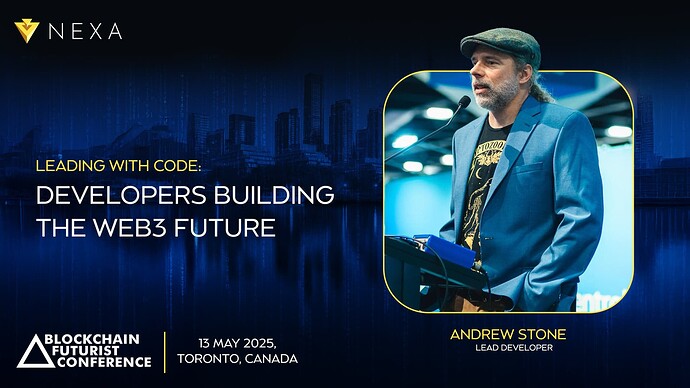Nexa’s founder and lead developer, Andrew Stone, took the stage at the Blockchain Futurist Conference 2025 in Toronto as part of a high-level panel titled “Leading with Code: Developers Building the Web3 Future”. The discussion brought together prominent voices in blockchain to explore the evolving identity of Web3 developers, the growing role of AI in development workflows, and the deepening complexity of decentralized infrastructure.
What Is a Web3 Developer?
The session opened with a deceptively simple question: What makes a Web3 developer different from a Web2 developer? Andrew Stone offered a critical, systems-level insight, emphasizing that Web3 development isn’t just about switching tech stacks, instead, it’s about building for an antagonistic environment, where other programs actively try to exploit or disrupt your code, and highlighted the architectural realities that define the Web3 paradigm, lack of trust in infrastructure, avoidance of centralized data collection, and user demand for privacy-first, passwordless systems. For developers, this means rethinking the entire software lifecycle, from interaction models to security assumptions.
A major theme in the panel was the increasing use of AI in development. While several speakers acknowledged the usefulness of tools like ChatGPT and Grok, Andrew Stone issued a caveat–you can use AI, but you must understand every line it writes. AI can assist, but it does not replace the foundational knowledge required to build resilient, secure blockchain applications, and emphasized that the current trajectory of AI development still requires more engineers, not fewer, particularly those with strong skills in math, formal languages, and secure systems design. The panel also touched on blockchain infrastructure fragmentation, while Ethereum remains dominant, Andrew Stone noted that innovation is moving quickly elsewhere–citing Nexa’s own research into RISC-V and alternative VM implementations, and framed the future not in terms of a “winner-takes-all” chain, but rather in terms of purpose-built blockchains working in parallel.
Final Thoughts
Andrew Stone’s presence reflected Nexa’s ongoing commitment to substance over hype, and made a clear call for pragmatic thinking in Web3–focus on infrastructure that works, deliver real value to users, and make it accessible enough that even non-technical people can participate without fear or confusion. As mass adoption hinges on usability, reliability, and decentralization, Nexa continues to lead with code and with purpose.

